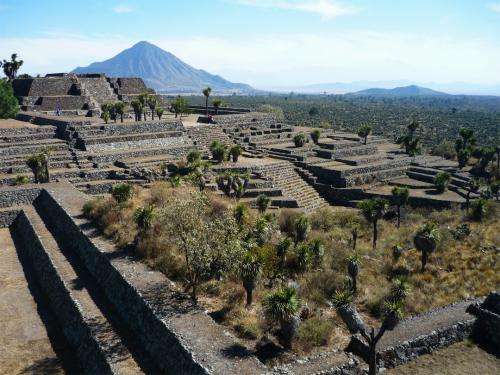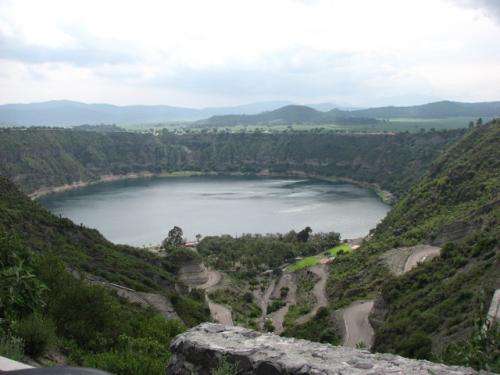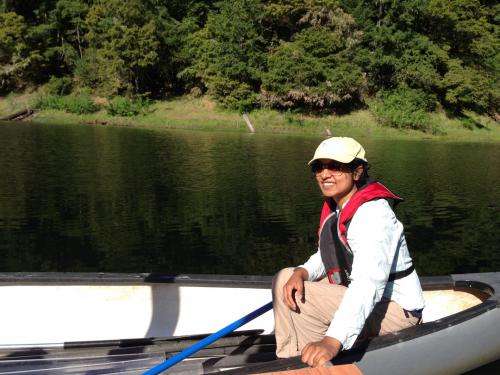Long dry spell doomed Mexican city 1,000 years ago

Archaeologists continue to debate the reasons for the collapse of many Central American cities and states, from Teotihuacan in Mexico to the Yucatan Maya, and climate change is considered one of the major causes.
A UC Berkeley study sheds new light on this question, providing evidence that a prolonged period of below-average rainfall was partly responsible for the abandonment of one such city, Cantona, between A.D. 900 and A.D. 1050.
At its peak, Cantona, located in a dry, volcanic basin (La Cuenca Oriental) east of today's Mexico City, was one of the largest cities in the New World, with 90,000 inhabitants. The area was a major source of obsidian, and the city may have played a military role alongside an important trade route from the Veracruz coast into the highlands.
To assess the climate in that area before and after Cantona's collapse, UC Berkeley geographers analyzed sediment cores from a lake located 20 miles south of the former city. They found evidence of a 650-year period of frequent droughts that extended from around A.D. 500 to about A.D. 1150. This was part of a long-term drying trend in highland Mexico that started 2,200 years ago, around 200 B.C. The climate became wetter again in about A.D. 1300, just prior to the rise of the Aztec empire.
"The decline of Cantona occurred during this dry interval, and we conclude that climate change probably played a role, at least towards the end of the city's existence," said lead author Tripti Bhattacharya, a UC Berkeley graduate student.
Surprisingly, the population of Cantona increased during the early part of the dry period, perhaps because of political upheaval elsewhere that increased the importance of the heavily fortified city, she said. Teotihuacan, less than 100 miles to the west, was in decline at the time, also possibly because of more frequent droughts.

"In a sense the area became important because of the increased frequency of drought," said UC Berkeley associate professor of geography Roger Byrne. "But when the droughts continued on such a scale, the subsistence base for the whole area changed and people just had to leave. The city was abandoned."
Bhattacharya, Byrne and their colleagues report their findings in an article appearing this week in the early edition of the journal Proceedings of the National Academy of Sciences. The UC Berkeley researchers analyzed lake cores provided by scientists at the National Autonomous University of Mexico in Juriquilla, Querétaro, Mexico and the German Research Centre for Geosciences in Potsdam, Germany.
Political upheaval and climate change
Byrne emphasized that the area's typical monsoon weather with wet summers and dry winters did not stop, but was interrupted by frequent short-term droughts, no doubt affecting crops and water supplies. Today the area is close to the northern limit of maize production without irrigation, and would have been particularly vulnerable to drier conditions, he said.
Byrne, a member of the Berkeley Initiative on Global Change Biology (BiGCB) and curator of fossil pollen in the Museum of Paleontology, has studied sediment cores from many lakes in Mexico and California, and is particularly interested in possible links between climate change and human activities.

Nearly 20 years ago, he learned of Cantona and traveled with students to the areas three times to obtain cores from lakes near the site, most of which are maar lakes created by magma explosions. They are deep and often contain undisturbed and regularly layered sediments ideal for chronological studies.
German colleagues cored this particular lake, Aljojuca, in 2007, and Bhattacharya traveled to Potsdam to collect sediment samples. Oxygen isotope ratios in carbonate sediments are correlated with the ratio of precipitation to evaporation and thus indicate aridity. Organic material in the sediments was used for accelerator mass spectroscopy carbon-14 dating.
"We can show that both the growth and decline of the site took place during a time period of frequent drought, which forces us to think in more nuanced ways about how political and social factors interact with environmental factors to cause social and cultural change," Bhattacharya said. "That makes the study particularly interesting."
Bhattacharya noted that more studies are necessary to reconstruct the prehistoric climate of highland Mexico. Such studies could reveal the causes of prehistoric climatic change and whether they were similar to the factors that regulate the region's climate today, such as the El Niño/Southern Oscillation.
More information: "Cultural implications of late Holocene climate change in the Cuenca Oriental, Mexico" Tripti Bhattacharya, PNAS, DOI: 10.1073/pnas.1405653112
Journal information: Proceedings of the National Academy of Sciences
Provided by University of California - Berkeley





















